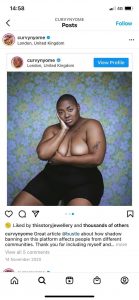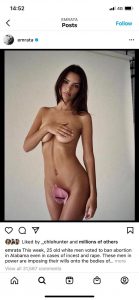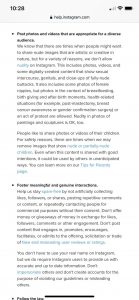Grace Baker
A couple of years ago third wave feminism, particularly choice feminist movements, were being questioned and discussed. It may seem outdated, then, to be rehashing old problems. However, in light of new Instagram community guidelines (yawn), Instagram has become a sort of microclimate of society. It highlights the ever emergent problems of choice feminism.
So what is choice feminism?
The original fight against choice feminism began in 2006 when Linda Hirshman coined the phrase in order to denounce it. It puts a label to concepts that had taken over feminist movements in the 1980’s. It pushed back against the strict idea that women should neglect the home and get to work. Instead, this new ideology purported that after years of oppression women should be able to make whatever choices they want. Deciding not to work, having a plethora of children, being promiscuous or not, shaving or not and the list goes on.
Women should simply be empowered in their choices and all such empowerment is deemed feminist under the choice feminist banner.
It can be seen as arising out of criticisms levelled at feminism; that it is too radical, too exclusionary, and too judgemental (Ferguson 2010). Choice feminism, instead, does not really challenge society. It ensures that everyone can be included in feminism (we wouldn’t want to lose any allies!). It also guarantees that people cannot be judged since all choices are valid and, therefore, not open to moral indignation. Choice feminism is, thus, increasingly used by women in order to present their empowerment as feminist.
For example, Emily Ratajkowski recently published an article ‘Buying Myself Back’ and not too long ago ‘Baby Woman’. She claims that her empowerment is, quite simply, owning her body and presenting it however she wishes. This has been framed as feminist activism. I think this is dangerous.
Choice feminism has the ability to take feminism out of context.

It skims over the intricacies involved, especially within intersectional feminism. Kimberlé Crenshaw highlighted the important ways in which race, gender and socio-economi
c background intersect in the lived experience of women. This theory has since been broadened to include a wide range of different disadvantages people may face. Such intersections are highlighted when we contrast the way in which @emrata, as she is known on Instagram, is able to post empowering pictures compared to Nyome Nicholas-Williams.
Nyome (@curvynyome) posed topless wearing black bicycle shorts only. This picture was frequently taken down by Instagram as it was deemed to ‘break their rules’. This resulted in the circulation of the ‘I want to see Nyome’ campaign.

In comparison, Emily can pose fully naked but for a flower over her vulva, among many other risqué photos, and yet these pictures are not removed.
Both images comply with the Instagram guidelines as neither show full nudity nor nipples. However, Instagram explained that it was a former policy on ‘boob squeezing’ that had caused Nyome’s photo to be taken down. In my opinion, Nyome’s photo does not include any more ‘boob squeezing’ than Emily’s. Instead, she is attempting to cover more of her bigger boobs. The rules, therefore, have been applied unevenly. I think it is worth looking at why this may be the case.
Emily has white privilege, pretty privilege, skinny privilege (to name a few). Her posture is also more open and alluring whereas Nyome’s is closed off which could be seen as intimidating. Nyome’s buzz cut hairstyle also presents as more androgynous. Therefore, it can be assumed that Emily fits better into the economy of the male gaze.
Thus, though it can be incredibly empowering to freely express your sexuality and  make money from it, not everyone is given this choice.
make money from it, not everyone is given this choice.
It seems impossible, then, to say that Emily’s choices are feminist.
They still buy into the commodity of women, into the male gaze, and into what society deems to be beautiful. Such ‘choice feminism’ clearly hides important aspects of intersectionality. In this case being a black, plus-sized, less womanly (on societies’ standards) individual means her choices are lacking.
So what is the solution?
We need to delete choice feminism and actually create a feminist political stance.
This includes making judgements, creating change in society, and in some cases excluding those stuck in the status quo. This is okay.
We may not always get it right. Judging is a political skill and we all need practice. It is the skill of defining and explaining what actions and choices actually benefit the feminist movement. It is creating arguments for the case and hoping other people jump onboard. We may fail. If we do, we need others to hold us accountable. Therefore, we need to be open to the risks of being political, feminist activists. We need to find ‘pleasure in politics’, as Ferguson advocates, even when it feels incredibly uncomfortable.
It is time to embrace not just feelings of empowerment in our choices, but the uncomfortable feeling of being in the realm of risk.
Emily Ratajkowski’s articles:
https://www.lennyletter.com/story/emily-ratajkowski-baby-woman
https://www.thecut.com/article/emily-ratajkowski-owning-my-image-essay.html
Instagram Community Guidelines:
References:
Ferguson, M. L., (2010), ‘Choice Feminism and the Fear of Politics’, Perspectives on Politics, 8(1), pp.247-253
Hirschman, L. R., (2006), Get To Work: A Manifesto for Women of the World, New York: Viking
Crenshaw, K., (1989), ‘Demarginalizing the Intersection of Race and Sex: A Black Feminist Critique of Antidiscrimination Doctrine’, University of Chicago Legal Forum, 1989(1), pp.139-168
